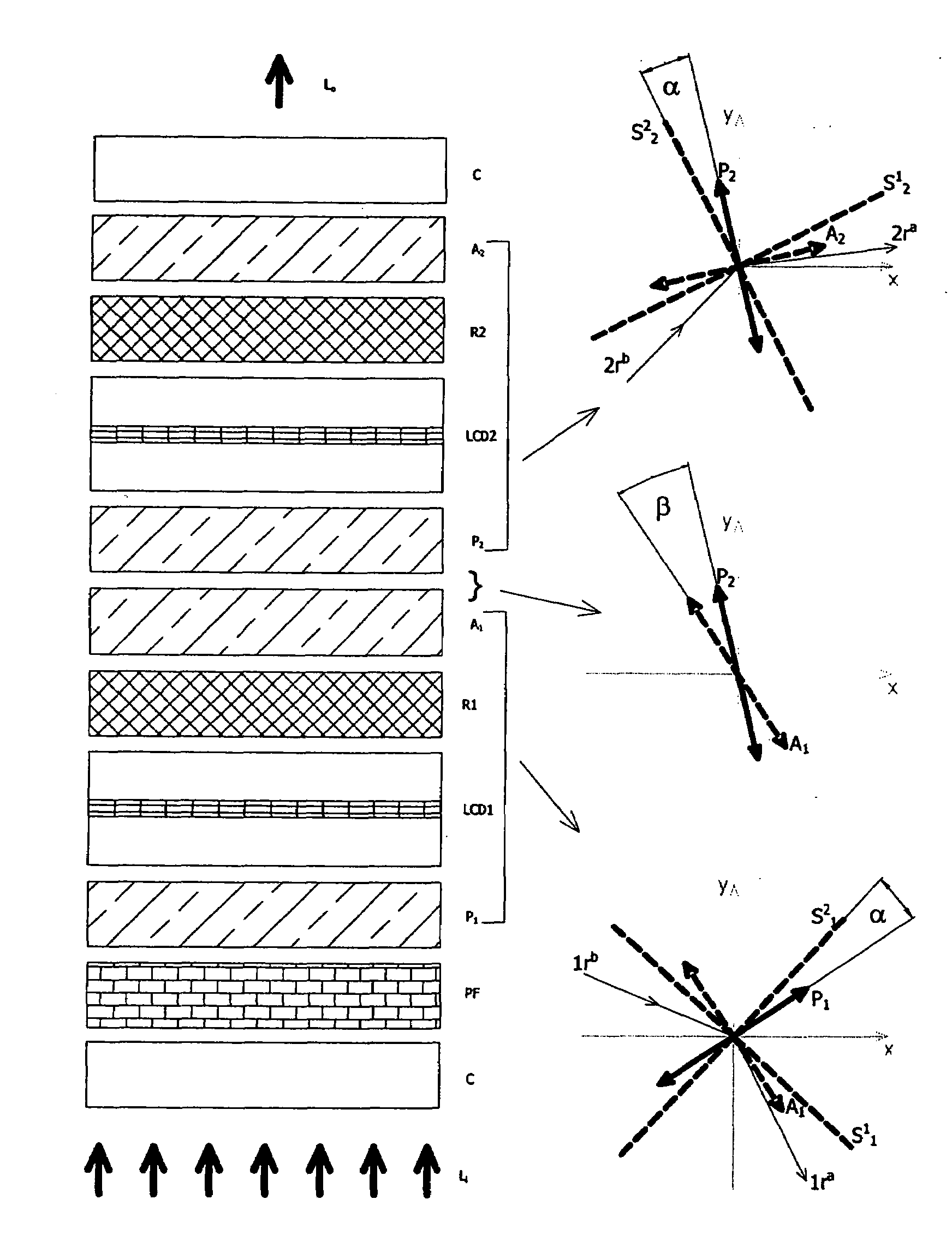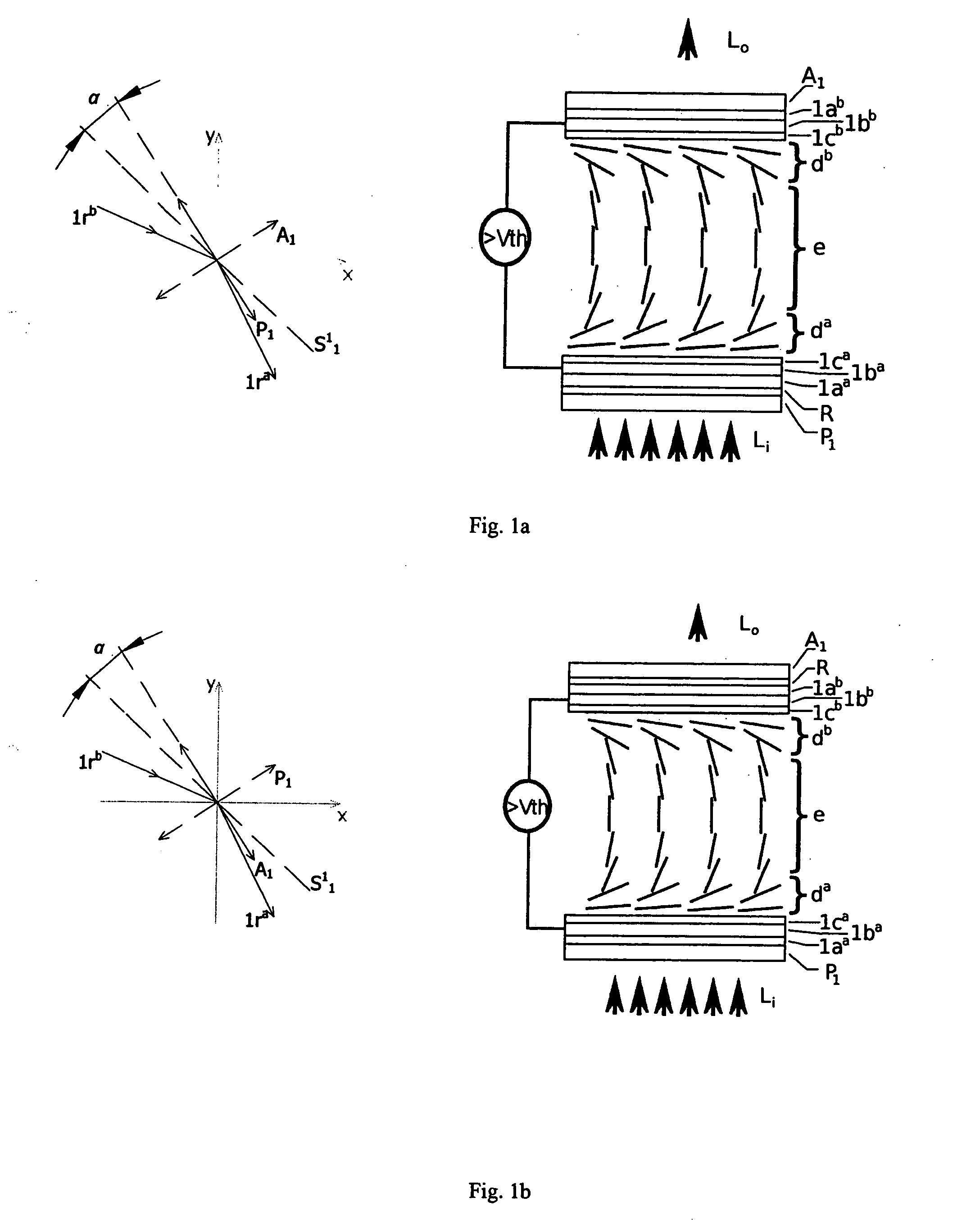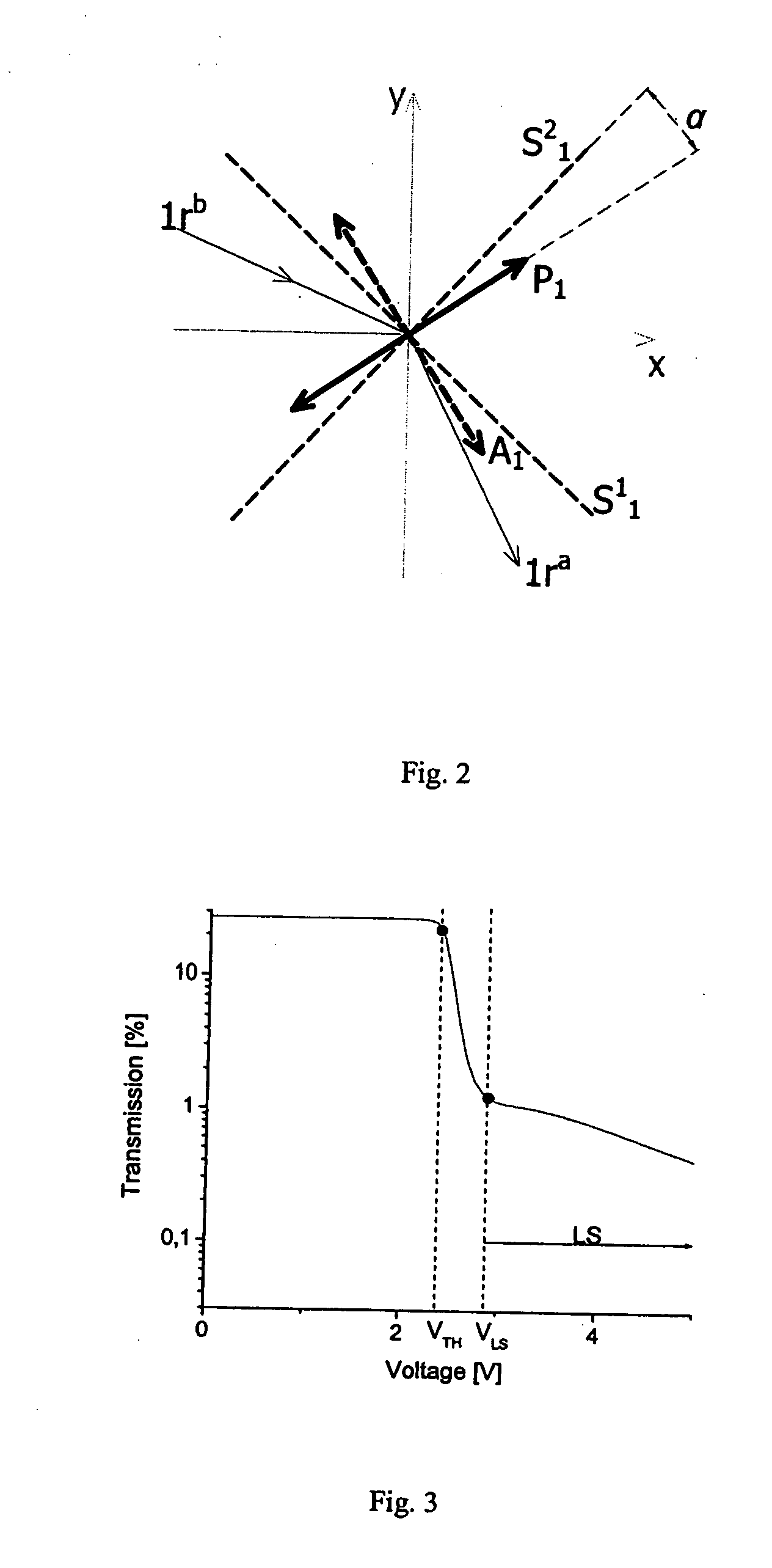[0012]The object of the present invention is to provide a LCD light-switching
optical filter allowing for very high, electrically controlled, continuously variable light attenuation (up to ≧100,000) optimized / symmetrized for the light incidence along the normal to the LCD plane.
[0015]Key features of the proposed invention and / or its advantageous embodiments are the highly twisted
Liquid Crystal (LC) molecular orientation of the LCD light
shutter, its operation in the “low-slope regime LS” of the
light transmission / driving
voltage characteristics (FIG. 3) and the complementary dual LC-
cell configuration of the LCD light switching filter (FIGS. 9a, b). The resulting overall symmetry of the proposed LCD light switching filter allows for very high, continuously electrically variable optical attenuation, as well as efficient angular compensation using just simple, low cost negative-birefringent c-plate retarders. The proposed technical solutions according to the invention noticeably improve the overall optical performances of the LCD light-switching filters, which significantly exceed the highest requirements of the international
safety standards (i.e.: EN 379, . . . ) for
eye protection devices:
[0022]Ad a. Since the required high level of light attenuation can be achieved only by using two LCD light shutters in a tandem, relatively low light attenuations (45-350) are required for each of them to cover the entire protective range, as required by international standards like EN 379. So relatively low light attenuation typically achieved with STN LCDs is not a problem. Moreover, higher driving electric fields, necessary for achieving the same light attenuation as the standard TN LCD light shutters, as well as the overall HTLS operational concept, result in noticeably better
homeotropic alignment of the LC molecules in the optically
closed state than with the conventional TN or LTN technologies (see FIG. 7). This property can be very efficiently used to help compensating for the
angular dependence of the light attenuation (see Ad d for details).
[0028]Such a dual “complementary” LCD construction of the filter makes the constraint for the crossed polarizers P1, A1 adjacent to the first LC-
cell LCD1 and for the crossed polarizers P2, A2 adjacent to the second LC-
cell LCD2 being aligned along the symmetry axes S′, and S21 of the LC alignment directions of the first LCD1 respectively along the symmetry axes S12 and S22 the second LC-cell LCD2 less strict, as the angular dependencies of the
light transmission of said two complementary LC-cells compensate each other. The use of a tandem of complementary LC-cells therefore allows for some rotation of the crossed pairs of polarizers P1, A1 and P2, A2 for a relative angle α away from the said ideal orientations (FIG. 2). The light transmission / driving voltage characteristics noticeably depends on the relative angle α between the crossed polarizers P1, A1 respectively P2, A2 and the symmetry axes S11, S21 respectively S12, S22 (see FIG. 5). Therefore the said angle α can be further used to optimize the overall absolute value of the light transmission characteristics and broaden the interval LS for the “dark scale” operation of the LCD light switching filters as well as to broaden the overall viewing angle of the LCD light switching filter in the optically
closed state.
[0029]Ad d. The dual “complementary” HTLS construction significantly simplifies the problem of angular compensation of the light attenuation in the optically
closed state of the LCD light switching filter. Besides the superior angular independence of the light attenuation as compared to standard TN or LTN solutions, which results from the high symmetry of the LC-molecular orientation in the HTLS construction, the viewing angle can be further expanded by optimizing the relative angle α between the crossed polarizers P1, A1 and P2, A2 and the LC alignment 1ra, 1rb and 2ra, 2rb (see also the Detailed description). Finally as already mentioned (Ad a) HTLS concept exhibits increased
homeotropic alignment (see FIG. 7), which can be very efficiently compensated by the addition of only a simple negative-birefringent c-plate
layers R1 respectively R2 built-in between the two LC-cells LCD1 respectively LCD2 and the adjacent crossed polarizers P1, A1 respectively P2, A2 (claim 8). A combination of all these effects results in a very appropriate overall angular compensation of the light attenuation, which is in complete compliance with the highest demands of the international standards like EN 379. The excellent
angular dependence (see FIG. 8) for the optimized value of the additional negative-birefringent c-plate
layers R1 respectively R2 results from the fact that the relative positioning of the said negative-birefringent c-plate
layers R1 respectively R2 according to this
patent application (claims 9, 10, 11), allows not only for compensating the angular dependence of the homeotropically oriented central part e of the LC molecular layer (see FIG. 1) with both LC-cells LCD1 and LCD2 but also for a great deal of the angular dependence of the crossed polarizers P1, A1 and P2, A2 adjacent to the LC-cells LCD1 and LCD2. The said additional
compensation effect can be achieved, if the effective “negative-retardation” of the said negative-birefringent c-plate layers R1 respectively R2 is deliberately chosen to be smaller than the effective “positive-retardation” of the homeotropically oriented central LC-molecular layer e (see FIG. 1). The resulting positive-
birefringence having the optic axis aligned along the normal to the LC-cell (“c-plate”), if combined with the residual in-plane (“a-plate”) positive-
birefringence of the boundary LC-molecular layers da, db can result in a rather efficient compensation of the angular dependence of the crossed polarizers P1, A1 and P2, A2 adjacent to the LC-cells LCD1 and LCD2.
[0031]The proposed “HTLS concept”, assuming twisting of the LC-molecular ordering through the LC-cells LCD1 and LCD2 well beyond 90°, optionally using a dual “complementary” LC-cell filter structure and rotating the crossed polarizers away from the symmetry axes between the LC-
molecular alignment directions at the LC-cell boundaries, provides an additional optical symmetry essential for the low angular dependence of the light attenuation. Optimization of the molecular twist angle, chiral
dopant concentration and the angle between the polarizers and the symmetry axes of the LC alignment directions at the LC-cell boundaries further results in the “ideal” electrooptic response and in the expansion of the viewing angle, which remains preserved through a broad range of driving voltages. Obtained high overall optical symmetry allows for the additional compensation of the LC cells with just simple, negative-birefringent c-plate retarders. The said retarders besides being low cost and easy to be tuned to specific LCD cells also have superior optical properties (WO 00 / 77561 A2) compared to the more sophisticated retardation films widely used in the computer and TV industry. “HTLS concept” therefore results in noticeably improved performances of the high
optical contrast LCD light switching filters, which significantly exceed the highest requirements of the international
safety standards [i.e. EN 379, . . . ] for
eye protection devices without increase of the production cost or complexity.
 Login to View More
Login to View More  Login to View More
Login to View More 


